Note: original Japanese name should be written "Nanbu", but "Nambu" transliteration seems to be used in English. As this review is for English-speaking audience, I decided to use "Nambu" instead of original name.HistoryJapan is traditionally seen as a country of swords and martial arts. "Gun and Sword Laws" prohibits possesion of firearms. While it is European and US guns that are most known, several firearms have been designed in Japan, most of them by Kijirō Nanbu (南部麒次郎). The few ones that have seen service before and during WWII (except for long arms) are:
- Type 26 revolver / 二十六年式拳銃 (1893)
- Grandpa Nambu (1902)
- Papa Nambu (1905)
- Baby Nambu (1907)
- Type 14 Nambu / 南部拳銃 (1925), with two distinct variants
- Type 94 / 九四式拳銃 (1934)
For more details see:
http://en.wikipedia.org/wiki/Nambu_pistolhttp://members.shaw.ca/tju/jhg.htmhttp://carbinesforcollectors.com/nambu.htmlThere were also some unusual designs, such as Hino Komuro pistol from 1908 - only about 1200 were hand-made, very few survived the war.
http://en.wikipedia.org/wiki/Hino_Komuro_M1908_Pistolhttp://www.guncollectorsforum.com/forums/showthread.php?t=2090This review will focus on Type 14, designed in 1925, based on previous Nambu designs. It used 8mm cartridges, also designed specifically for Nambu pistols in Japan. Externally Type 14 was very similar to previous models, yet easily distinguishable - Grandpa, Papa and Baby Nambu all had grip safety below trigger guard, while Type 14 got rid of this feature.
Baby Nambu pistols were copied (ha!, that's how piracy begins!) by Bill Ruger, but he decided to develop his own pistol based on Nambu - Ruger Standard. While Luger is definitely a different construction than Nambu, Ruger is a descendant of it.
More information:
http://en.wikipedia.org/wiki/Type_14_8_mm_Nambu_Pistolhttp://en.wikipedia.org/wiki/Kijir%C5%8D_NambuModelgunAs already noted, Japanese firearms are surprisingly unpopular among modelgun makers. Hudson decided to produce Type 14 in at least three editions, starting from paper caps (N1) to modern CP variants (N2 and N3). The latest edition (N3) was also available in small/large trigger guard versions, corresponding to early and late production period of the original Type 14. Marushin also released an airsoft version of Type 14 in 8mm caliber, same as original, while Tokyo Marui had a springer version a long time ago.
Marushin produces dummy model of Baby Nambu with at least two different marking versions. They also released a blowback Baby Nambu under ACG brand.
Type 94 model is produced by unknown (to me) company as a solid metal or rubber dummy. Rocken seems to have released a small quantity of Type 94 modelgun with moving parts, but no blowback.
N3 edition of Type 14 from Hudson was released in two slightly different versions corresponding to original Type 14 variations:
- early version, with round trigger guard and Tokyo Military Factory markings
- late version, with elongated trigger guard and Nagoya Military Factory markings
Information about Type 14 modelgun (mainly in Japanese):
http://homepage3.nifty.com/nkoinuma/J-Handguns.htmVery good comparisons of N1, N2 and N3 editions (in Japanese):
http://www7a.biglobe.ne.jp/~yon-yon/cgi/hudson/N1/index.htmlhttp://www7a.biglobe.ne.jp/~yon-yon/cgi/hudson/N2/index.htmlhttp://www7a.biglobe.ne.jp/~yon-yon/cgi/hudson/N3/index.htmlHudson factory closed in December 2009, so there is not much hope left to get any new production of Type 14 Nambu.
If interested, you should probably grab yours while you can.
The model I have reviewed is N3 (the latest edition), with large trigger guard, from the last batch made by Hudson.
BoxOriginally Hudson sold Type 14 in nice coloured boxes with cover text and various markings. The one I got was packaged in a plain, stapled cardboard box with a sheet of yellow paper attached to the top. It's very similar to these for Hudson Scorpion vz61 model. Unfortunately such simple packaging shows decline of the company :-( I think that Hudson initially used such boxes only for "Grade B" models that did not pass quality checks and were sold at lower prices.
Inside the box there was a modelgun itself, magazine, six CP cartridges, disassembly tool and instructions. Modelgun will be most likely also wrapped in bubbles by the person who ships you the package - especially if it is the cardboard box.
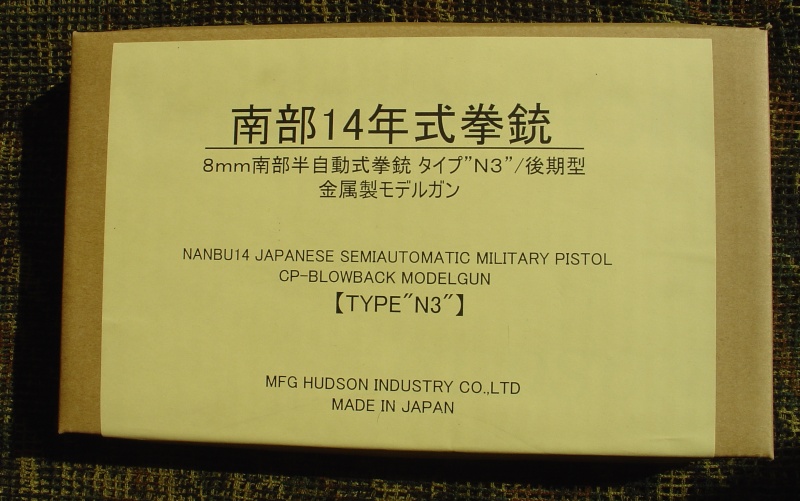

My version had photocopied (by Hudson!) instructions in black on two thin sheets of yellow paper.
Quality of text and pictures inside is ok, but the front/back page have very uneven black, probably because the original was in a different colour and did not give in to copying.
It contains 4 pages of very good usage, maintenance and take-down instructions (illustrated), exploded diagram, and parts list. The last page seems to explain various details of construction and maybe differences between N1/N2/N3 versions.
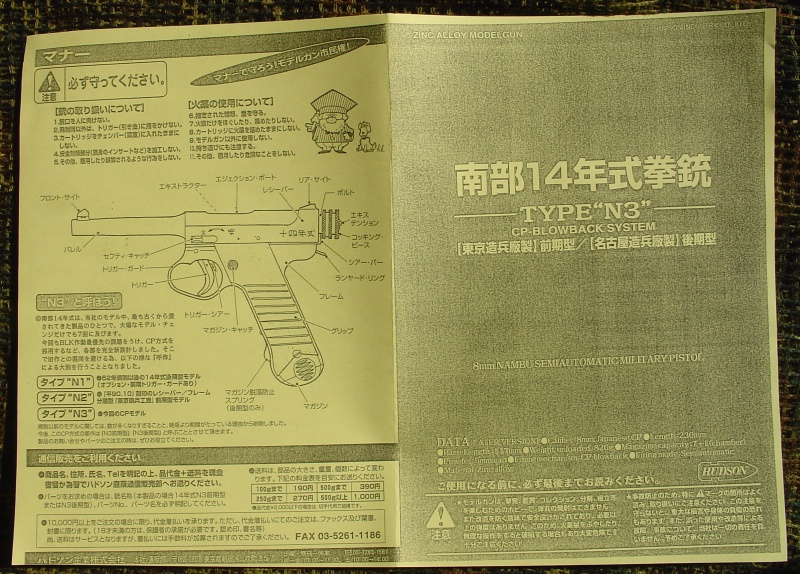

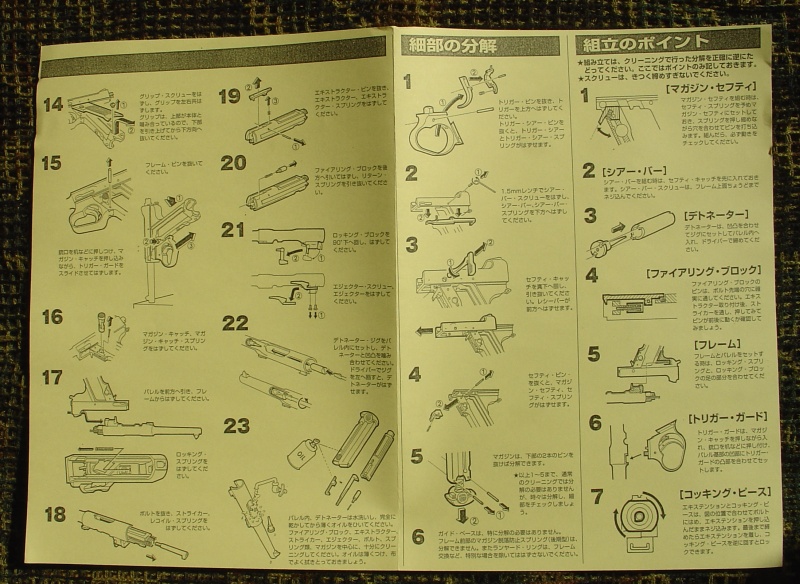
 Modelgun
ModelgunThis is a full metal modelgun - nice, shiny, heavy, looking great! :-)
It's made of metal, except for the wooden grips.
In compliance with Japanese law, metal is gold-coloured - maybe even gold-plated, I never found out if it's truth.
Model looks deceivingly similar to Luger P08, and it is often confused with Luger, but it has a completely different design. I guess it's the slanted grip, thin long barrel and shape of magazine bottom that lead to this mistake.
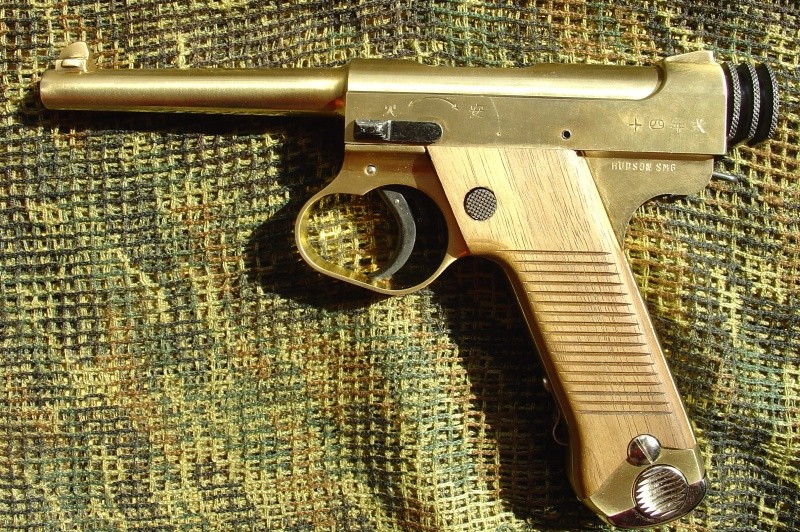


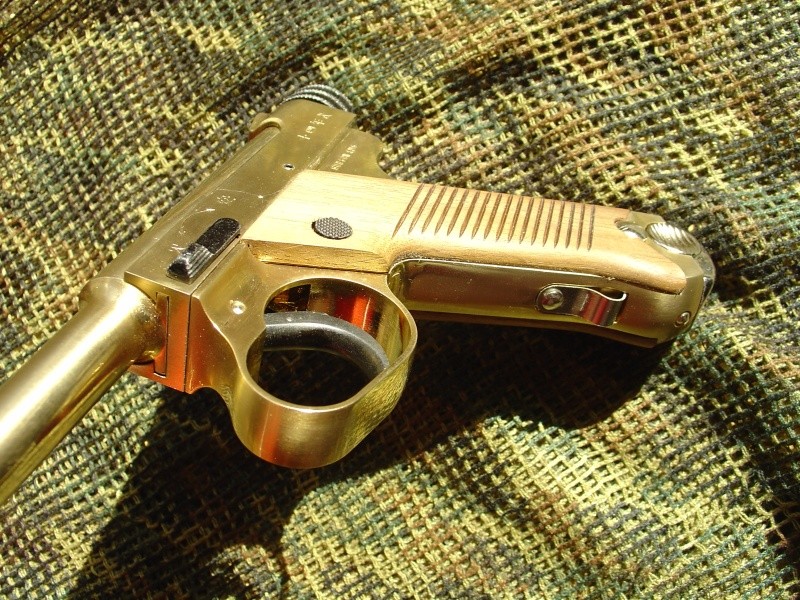

There are two finish pecularities that stand out - finish on model that I have is very uneven, with a lot of machining marks. Pictures of N1/N2 edition and also earlier runs of N3 edition show much better finish quality, so my guess is that the final batch could have been a stretch to get it out of the door.
The second thing is that some of the edges are rough - especially at the top of the back of grip, where it curves. This is felt when you grip the gun, rough edge gets between index finger and thumb, hurting your webbing. It's a bit similar to problem with Scorpion vz61 trigger guard, though at least Nambu guard is well finished.
Left side of the gun features controls.
There is a safety lever: forward = fire, backward = safe. It blocks the trigger when engaged. Lever rotates 180 degrees and it scratches the surface of the model, making an arc appear between its two positions - just like in a real Nambu! It is not possible to operate the lever with the same hand that holds the gun. Slide just above lever is marked with arrows and appropriate kanji (actual words "fire" and "safe").
Note: magazine acts as a secondary safety - it needs to be inserted for trigger to work correctly, similar to Browning HP.
Trigger guard in this "late" model is elongated. Early models of real Nambu had a smaller trigger guard, but this posed problems - it was not easy to put your finger in there while wearing gloves. Grandpa Nambu (the first in series) had even smaller trigger guard, almost a decorative one. Guard shape is very distinct and looks good.
Trigger is black, it has a second smaller spring-loaded lever behind, used for activating the mechanism.
Trigger can be pulled on uncocked model, making a clicking sound as something inside jumps.

Near back of the frame you will find "HUDSON SMG" marking, as well as four marks that mimic original Nambu markings.
These are four kanji that read "ju yon nen shiki", which stands for "Type 14".
Back of the gun features a cocking handle, black and knurled. It pulls the whole bolt backwards.
Just below the handle there is a lanyard loop.
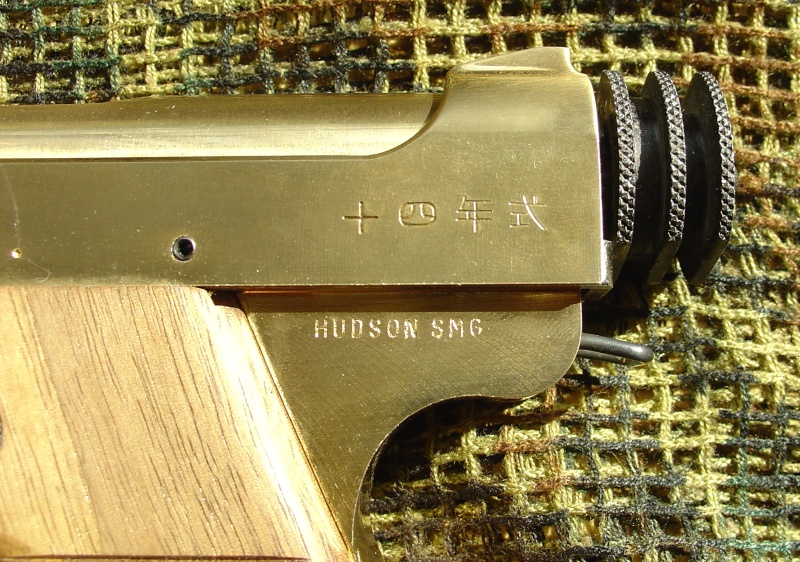
Grip panels are made of wood, they are held by two screws near the bottom of the grip. They have cutouts for mag release button - round and black, put in the modern place behind trigger guard.
Bottom of the grip has two round areas that you would grip to pull the magazine out. To prevent mag from falling out there is a tension spring, visible at the front of the grip, that makes pulling out/putting in of the magazine more difficult.
Going to the right side - no controls, just opposite end of all the pins. There are two markings near back of the frame.
The first one has four symbols, starting with Nagoya Arsenal mark, followed by "ro" katakana meaning "two" = second series (or "Series B") mark and two digits of a serial number: 86 in this case.
The second marking below is "shou" kanji (= Showa period) and manufacture date: 08.10, which is the tenth month of the eighth year (1933 = 1925 + 8 ) of Showa era.
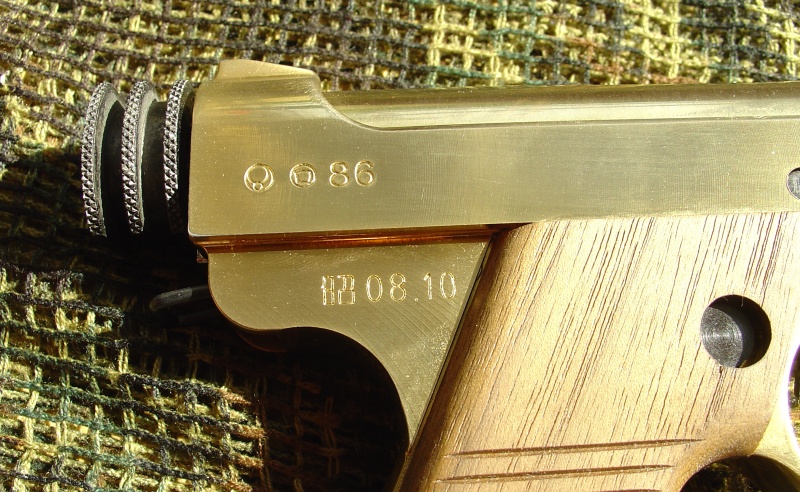
When bolt is pulled out, you can see it is marked "213" on top, not sure what this number means.
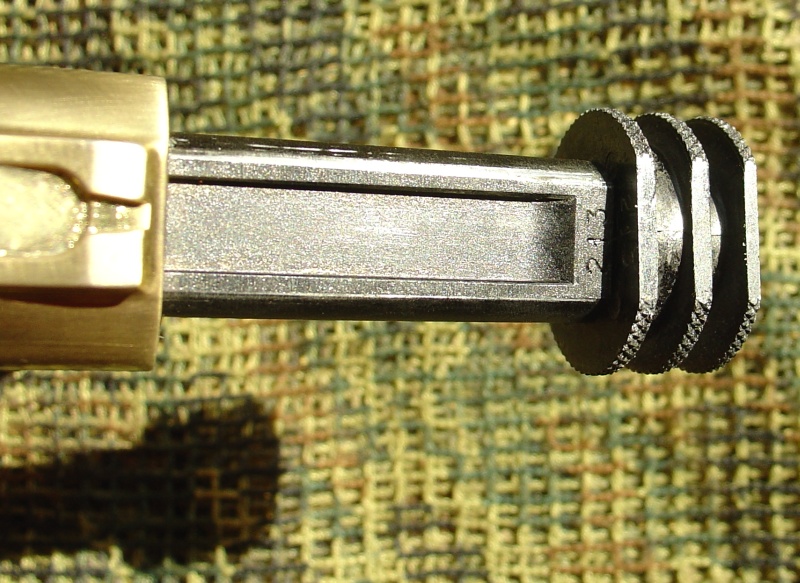
Hudson Nambu Type 14 model features classic open sights, integral with the slide. They cannot be adjusted.
Top of the model is fairly plain otherwise, except for the ejection port on top, through which you can see black bolt.
Barrel is fully blocked, as typical for metal modelguns. Depth is about 0.5cm (1/5")
MagazineMagazine looks similar to Luger P08 magazine. It is silver, with two round areas for gripping near the base.
It features two magazine lock cutouts, one for the proper magazine lock (button-operated), the other near bottom, for the spring lock. Bottom is held by two pins.
Right side has a button that allows to pull follower down (against the spring) for easier loading of cartridges.
Probably due to tolerances, or rough finish inside, as well as strong spring tension, there is a lot of friction when you pull it down.
Follower is black and it has two "prongs" near the back that should stop the bolt in back position when magazine gets empty. Of course when you remove mag to load it, the bolt will fall back forward.
Magazine capacity is 7 cartridges.
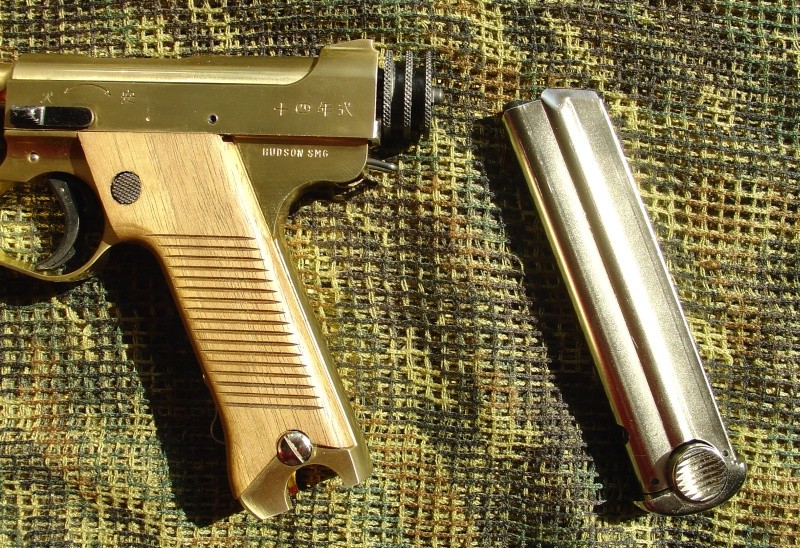

 Cartridges
CartridgesThere are several types of cartridges available for Hudson Nambu Type 14. The earliest version uses open type cartridges, but mine has modern CP cartridges. There are also dummy cartridges (decoration only, can't be cycled.
While it is easy to get dummy 9mm, or almost any other modern ammo, Nambu 8mm is quite unique and probably not readily available.
Internal cartridge design is based on MGC design: two parts that are unscrewed, a plug that goes in bottom, then cap, then a firing ping with an o-ring. Finally screw on the top. These cartridges do not have a "Hudson hole" in the top, maybe because full pressure is required to operate metal bolt (?).
Pictures show both dummy (left box, marked "dummy") and CP cartridges. There is 8 cartridges per box.
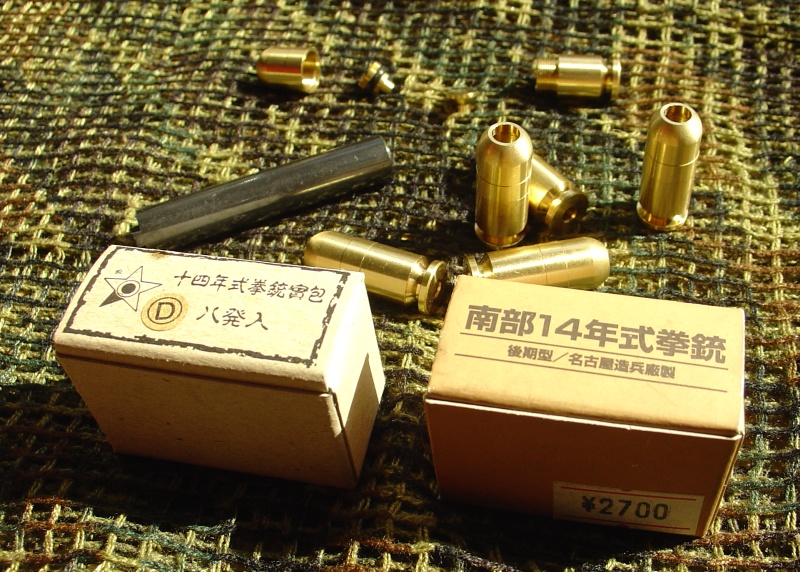
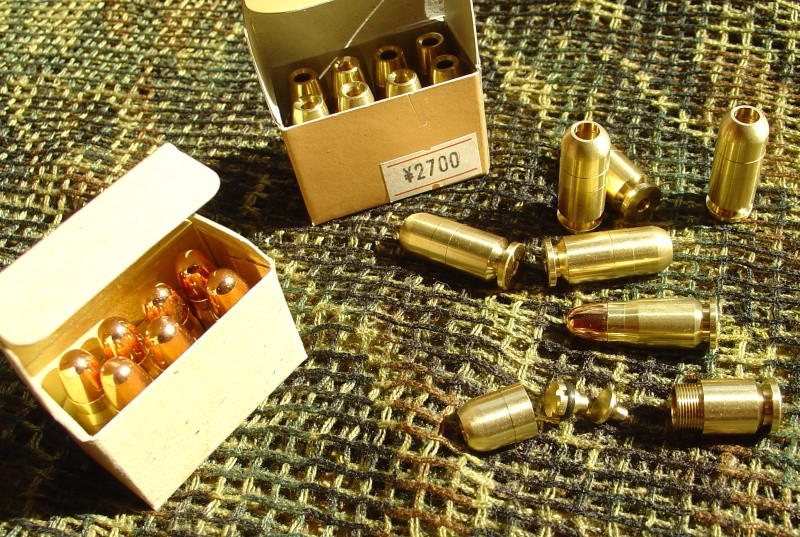 Firing
FiringI have not fired this model and do not plan to.
Those in the know say that performance is pretty poor, just like with other Hudson metal models.
For sure it is equipped with chamber, pin and other parts to operate it ;-)
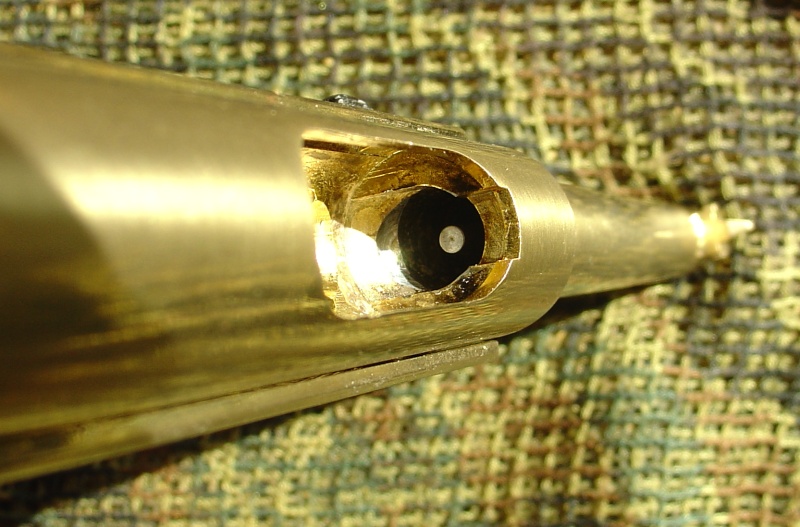 Problems
ProblemsExcept for quality of finish for this last batch from Hudson - no major complaints.
I have not fired this model, so I can't comment on performance.
Basic disassemblyIt is fairly well shown on pictures that are in original manual - you start by pushing knob on the bolt handle, then removing the bolt towards the back, and continuing with the process to get to the detonator pin.
Of course it looks much easier than it is done ;-)
I have not attempted disassembly (yet).
OverallHudson Nambu Type 14 is a very interesting design, refreshingly different from all these Colt 1911s or Walther PPKs available in such a variety from various modelgun makers. Nambu is even more interesting as this is one of a very few models of Japanese firearms on the market.
Construction is solid and satisfying - this model is a nice addition to collection :-)
